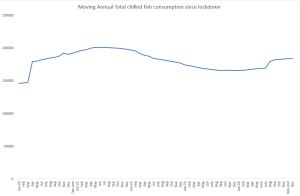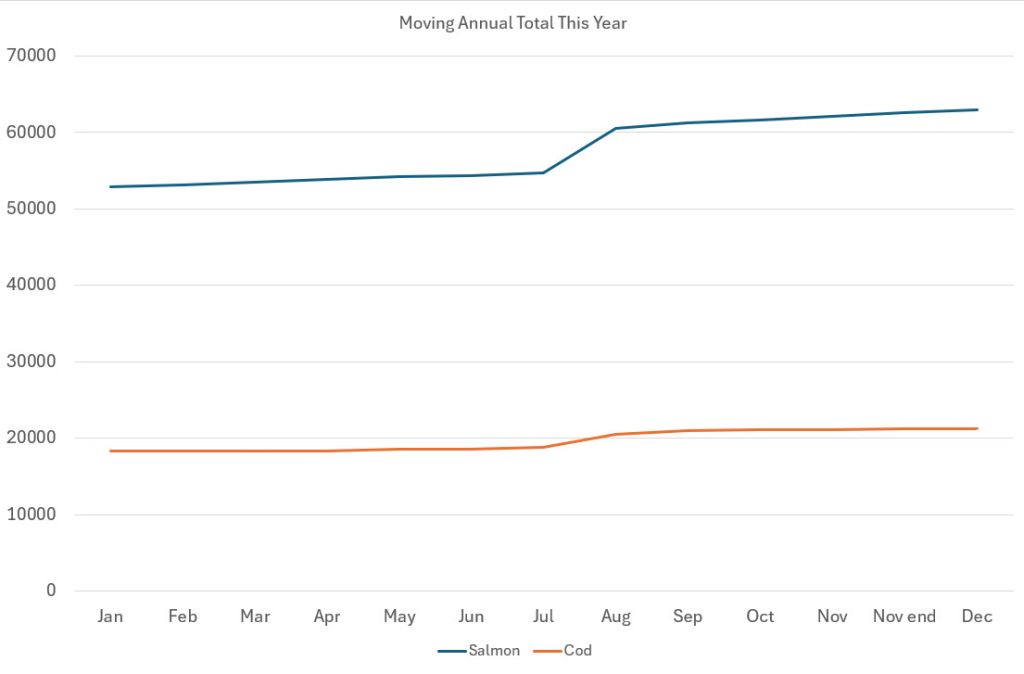Consumption: The news that Scottish salmon has set a new record for export value comes as no surprise. Scottish salmon remains the UK ‘s top export.
However, whilst salmon remains popular in 48 different countries, the good news is that consumption of salmon, as a chilled product, has grown in the UK too.
I have been tracking the total consumption of chilled fish and seafood since the UK went into Covid lockdown early in 2020. Consumption immediately shot up and then slowly increased until the summer of 2021 when the total consumption began a long decline through to the late summer of 2024, when there was a sudden increase which has continued until now.

When the total consumption was analysed, it was apparent that the uplift in consumption in 2024 has been driven mainly by salmon and cod.

Consumption of other species have mainly stagnated or fallen. Salmon is the star of the show.
Why salmon, and to a lesser extent cod, has seen increased consumption in the chilled sector is unclear. There have been retail promotions for both species but there have been other promotions for several other species too. Equally, there has been no apparent marketing campaign. Perhaps, we just need to accept this good news for what it is and hope that whatever has driven this increase will become apparent in the coming months so it might be applied to other species too.
Consumption too: What is clear is that the uplift in chilled salmon and cod sales is not the result of a new promotion from UK public body Seafish who have recently kicked off their ‘Seafood for Life’ promotion that is designed to bring more attention to the health benefits of fish and seafood.
Personally, I have never been a great fan of promoting fish as a healthy option. The public should be eating fish and seafood because it is good to eat, has great taste and is value for money. Any health benefits are an added bonus. In my view if fish and seafood is promoted as a healthy choice then that is how it will be perceived and those not looking for a healthy lifestyle will simply ignore it.
Seafish have partnered with three award winning seafood business in the UK to promote their campaign. Towngate Fisheries is a fish and chip shop in Bradford. Its comprehensive website seems to focus on taste and rightly so.
Fish City is a fish and chip shop and restaurant in Belfast. The restaurant offers a wide range of fish and seafood away from the traditional fish and chips. In 2018 it was voted the UK’s healthiest and most sustainable fish and chip restaurant but otherwise doesn’t really feature healthy eating.
The third business is Something Else Fishy, a fish and chip shop in Dorset. The website does not mention health eating.
The owner of Towngate Fisheries told Seafish that they were one of the first fish and chip shops to display the nutritional content of the meals having had every one professionally analysed. However, he also added that most customers are not interested in health aspects of fish and chips. Just one in ten might show an interest but he said that if you can attract that extra 10% of customers that it might make a difference between the business breaking even or making a profit.
It is quite a few years since Seafish dropped its marketing team saying that the money wasn’t big enough to make a difference and it could be spent better elsewhere. In my opinion it wasn’t the money that was the issue but the imagination. Inevitably, Seafish or the seafood industry does need to promote fish and seafood, but health is not the way.
Consumption 3. A new research paper from the University of Aberdeen’s Rowett Institute found that instead of exporting oily fish such as herring and mackerel, local consumption of these fish species could provide 73% of the recommended intake of omega -3 and 46% of vitamin B12.
The researchers have said that persuading people to eat more local seafood offers a significant opportunity both to improve public health and also to meet climate targets. This is because fish and seafood provide essential nutrients at much lower emissions that other animal-based proteins.
According to the study, the UK is a large producer of herring and mackerel which are relatively cheap for consumers to buy yet most of the fish are exported which indicates that consumer preferences and demand rather than a limited supply determines current patterns of fish consumption which is below the recommendation for consumption.
We didn’t need this study, which is part of the Scottish Government’s strategic research programme to tell us that. Consumption of fish such as mackerel and herring have been low for many years. We fell out of love with anything but the big five for a variety of reasons but mainly because we lost the knowledge of how to cook such species in our own kitchens and once this was lost, our children and our grandchildren wouldn’t be eating these fish too.
The researchers said that we used to eat a lot of herring – herring girls would travel down the country from Shetland to Great Yarmouth, processing and packing the silver darlings caught in the North Sea. It was an important part of our culture, and we should try somehow to revive the demand for oily fish.
And they wonder why the UK consumer no longer eat herring and mackerel.
At the end of 2024 consumption of chilled
Salmon – 62,910 t
Cod – 21,195 t
Mackerel – 6,625 t
Herring – 895 t
The researchers suggest that perhaps we should eat tinned fish instead. So far, they cannot match consumption of the chilled sector.
Mackerel – 9.038 t
Herring – 410 t
Kippers – 117 t
Consumption 4: Intrafish reports that the fish and chip shop sector continues to suffer last year with visits, spend and servings all dropping. Fish and chips are the big losers in 2024 within the foodservice sector losing 17% of visits, 4% on serving and 5% on spend. According to market analysts Circana, fish and chips is simply too expensive and because the average fish and chip shop customer tends to be older and less affluent, it has exacerbated the decline. Circana say the sector is in freefall whilst food service continues to expand. They say that even if the decline can be halted, they do not see the sector will return to growth. This is because there is nothing happening to suggest that it will.
None of this comes as any surprise. Aside from the expense, home delivery services have made all kinds of foods and from a greater distance accessible. The days of getting a takeout from the local chippy as the only choice are long gone. Competition is extremely stiff.
There is no doubt that as well as the competition, costs have soared, energy, oil, potatoes, and fish have all gone up in price. Yet, I often wonder why fish and chip shops have not helped themselves, at least in the case of fish. There is absolutely no reason why the fish must be expensive cod. There are lots of locally caught white fish species that the UK tends to ignore that make a good alterative to cod. They can also be marketed as a sustainable choice although as with health I don’t think most fish and chop shop customers consider sustainability when they buy their fish and chips. They just want a good tasting, value for money, meal.
There are two fish and chips shops near me and one full-service fish restaurant. Both the fish and chips shops are not exclusively fish oriented as one is also a souvlaki bar and the other seems to focus on kebabs. The cost of cod and chips is £13.50 for a medium portion and £15 for a large. Meanwhile, the restaurant charges £23 for the same.
What is clear as we approach the National Fish and Chip Shop awards later this month, what the sector needs is innovation. There is an innovation prize at the awards so it will be interesting to see what innovation wins.
Seafood Innovation 2025: This coming week, an invitation only event hosted by Centre of Environment, Fisheries and Aquaculture (CEFAS), the Department for Environment, Food and Rural Affairs (DEFRA and Seafish aims to showcase innovation across the UK seafood industry with a focus on innovations that span the entire journey from net to plate.
The conference programme can be viewed at https://drive.google.com/file/d/1R8JjD64YuHSwE8KxtRC179KhEhfeIq4X/view?pli=1
This includes innovation in Shellfish, Fisheries Gear, Aquaculture, Seaweed, the Supply Chain and Sustainability and includes participants from commercial enterprises, academia, technology and funding bodes.
This two-day event may well sound very exciting but in my opinion, there is a glaring omission. It is all very well and good innovating the fish and seafood sector but unless there is a focus on innovation in consumption, then any other innovation may become a pointless exercise. Without growing consumption, the fish and seafood sector serves little purpose. It is just not enough to go from net to plate, but we need to innovate how we get the fish and seafood we produce into the consumers’ stomach.
The programme includes closing remarks from the UK Seafood Innovation Fund Programme Steering Group Chair. The UK Seafood Innovation Fund programme put over £10 million into projects that intended to deliver cutting edge technology and innovation. Priority was given to innovative technologies for sustainable seafood production; increasing seafood productivity; increasing seafood sustainability; reducing commercial risk and strengthening the basis of sustainable fisheries management.
What they weren’t interested in was boosting seafood consumption. The only project really aimed at consumers was one that renamed megrim as Cornish sole in order to increase its appeal to consumers. Sadly, as I rarely see either in the retail sector, I can assume the project was not a great success.
I believe that the fund dispensed funding some time ago, but some projects will not come to an end until this year. It will be interesting to see how many of the projects became commercial success stories and what return on investment the Government got from its £10 million spend.
Meanwhile, the unanswered question is how can those consumers who never eat, or rarely eat fish be persuaded to do so? Equally, how can others be persuaded to move away from the Big Five and eat lesser known species such as coley, ling, and whiting. Finding solutions to such questions would really be innovative,

